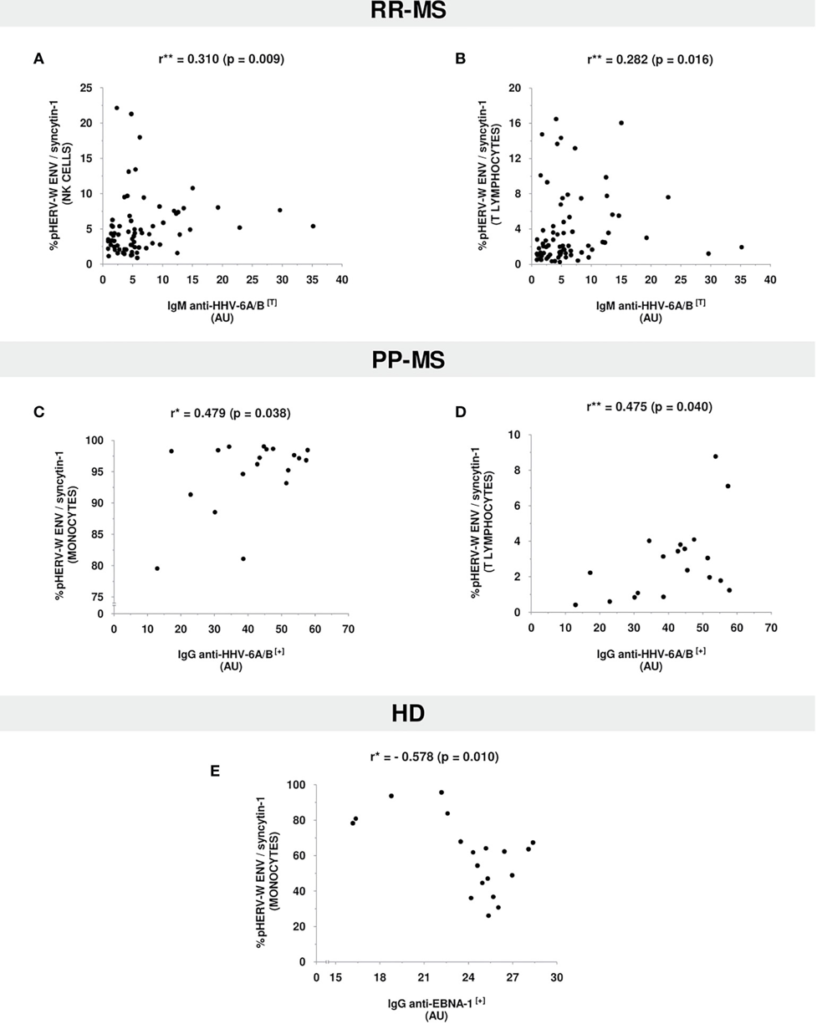Significant positive correlations were found between HERV family proteins and antibodies to HHV-6A/B but not antibodies to EBV.
Expression of the human endogenous retrovirus W (HERV-W) ENV proteins have been linked to the development of MS. HHV6/A and EBV virus also have been postulated to contribute to the pathogenesis of MS.
To investigate the possible interaction of these three viruses in people with MS, Perez-Perez and colleagues from several hospitals in Madrid, Spain, correlated the levels of HERV-W ENV protein in various types of immune cells with antibodies to HHV-6A/B and with antibodies to EBV. Blood samples from 101 MS patients with either relapsing-remitting MS (RR-MS) or with progressive MS (PP-MS), as well as from 37 healthy donors, were evaluated. Levels of HHV-6-IgM and -IgG were measured by ELISA. Levels of HERV-W ENV protein in different immune cells were measured by flow cytometry and qPCR.
Patients with both types of MS had significantly more HERV-W ENV protein expression than healthy donors, a difference observed in monocytes, B lymphocytes, and NK cells, but not in T lymphocytes.
In patients with RR-MS, anti-HHV-6A/B IgM levels were positively correlated with HERV-W ENV protein expression levels. In patients with PP-MS, anti-HHV-6A/B IgG levels were correlated with HERV-W ENV protein expression levels. In RR-MS patients, the correlation between HERV ENV proteins and IgM antibodies was found in NK cells and T lymphocytes. In progressive MS patients, the relationship between IgG antibodies and HERV proteins was found in T lymphocytes and monocytes.
In contrast, and despite strong epidemiologic evidence from serologic studies implicating EBV in the pathogenesis of MS (Bjornevik 2022), no association between EBV EBNA antibody levels and HERV-W ENV protein expression levels was found in people with either type of MS. And in healthy donors, there was a negative significant correlation between anti-EBNA-1 IgG antibodies titers and HERV-W ENV protein expression levels in monocytes. (Figure 1)

Figure 1 - Significant positive correlations between HHV-6 IgG and IgM antibodies in people with relapsing (RR-MS) and progressive (PP-MS) MS patients, and significant negative correlation between EBV-EBNA-1 IgG antibodies and HERV family proteins in healthy people
There is growing evidence that EBV, HHV-6A and activation of HERV-W endogenous retroviruses may each contribute to the pathogenesis of MS. This study and others also suggest that interaction between these viruses may be required. Serologic studies strongly suggest that EBV infection may be a necessary factor, but it clearly is not sufficient: the vast majority of people infected with EBV never develop MS. EBV may contribute to pathogenesis through molecular mimicry in which an autoimmune response to an EBV-EBNA-1 transcription factor epitope that attacks a glial cell adhesion factor (Lanz 2022).
HHV-6A/B may contribute through the expression of miRNAs related to autoimmune and inflammatory processes (Rizzo & Di Luca 2018) in NK cells, and/or by impairing remyelination by infecting and impairing the function of oligodendrocyte precursor cells (Campbell 2017).
Further studies looking simultaneously at the roles of EBV, HHV-6A and HERV-W endogenous retroviruses in MS are warranted.
Read the full article: Perez-Perez 2021

